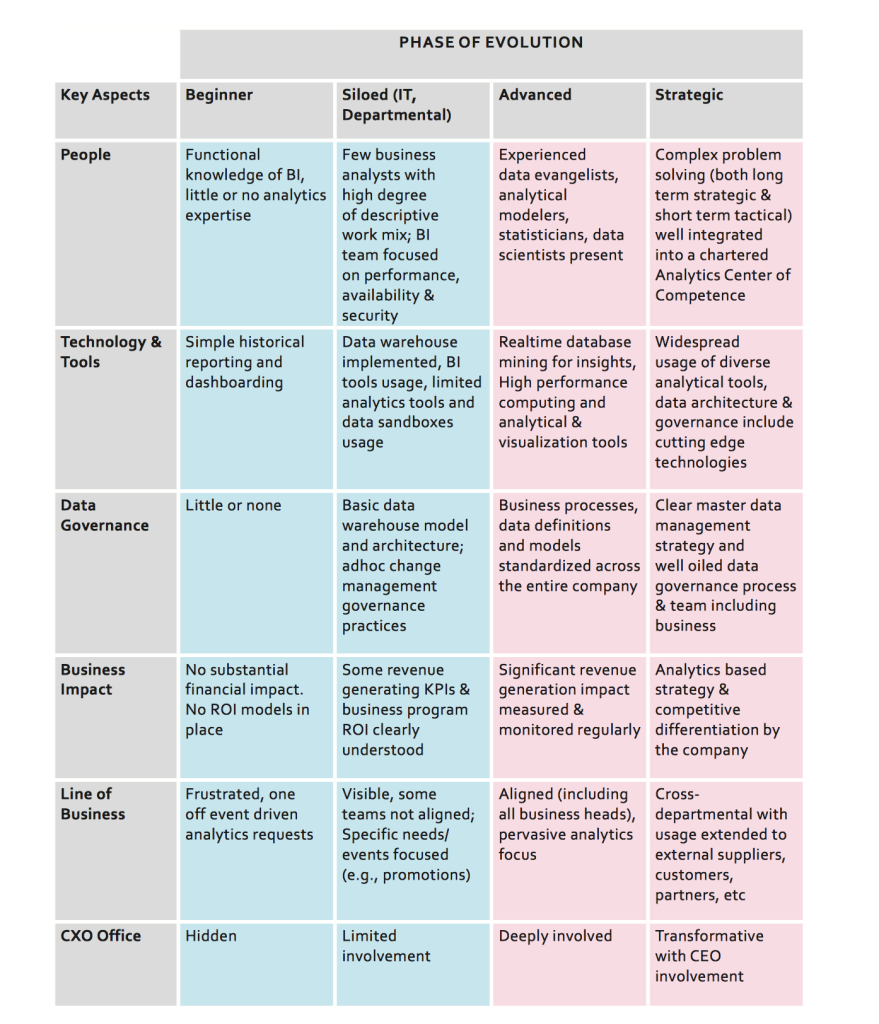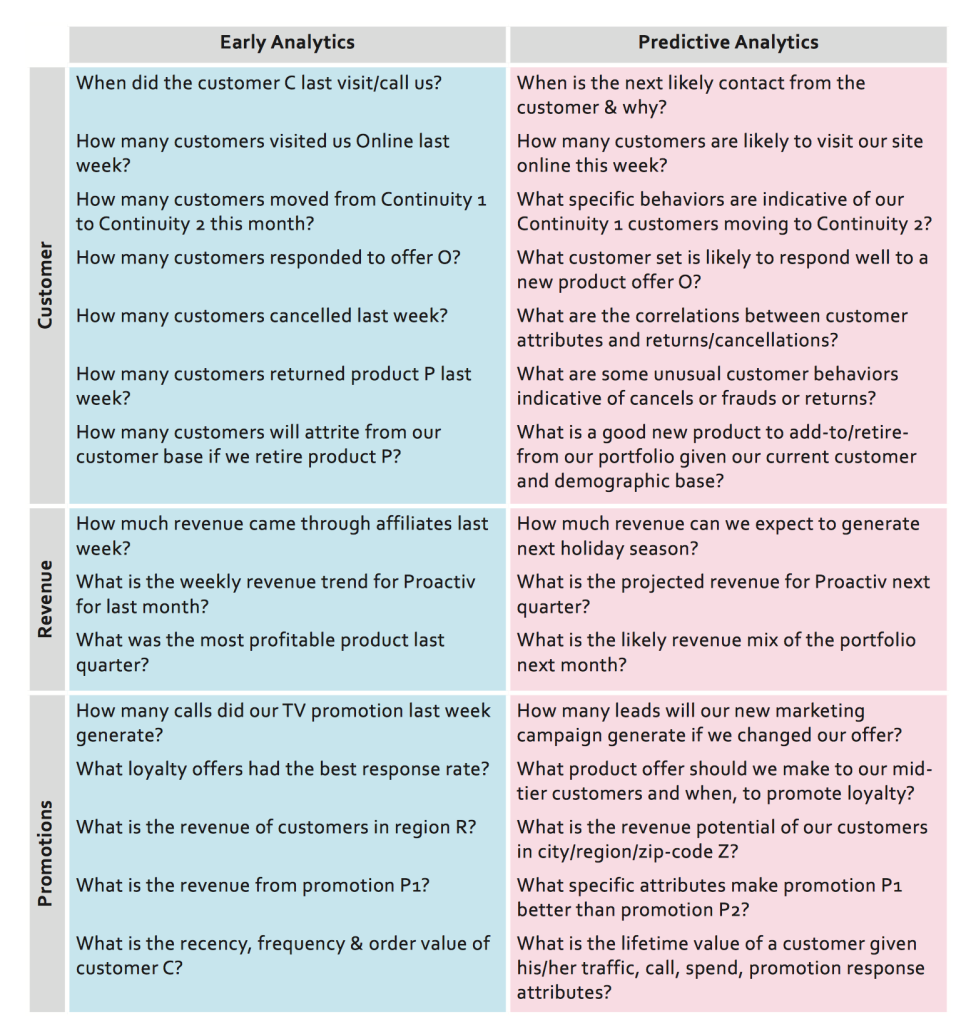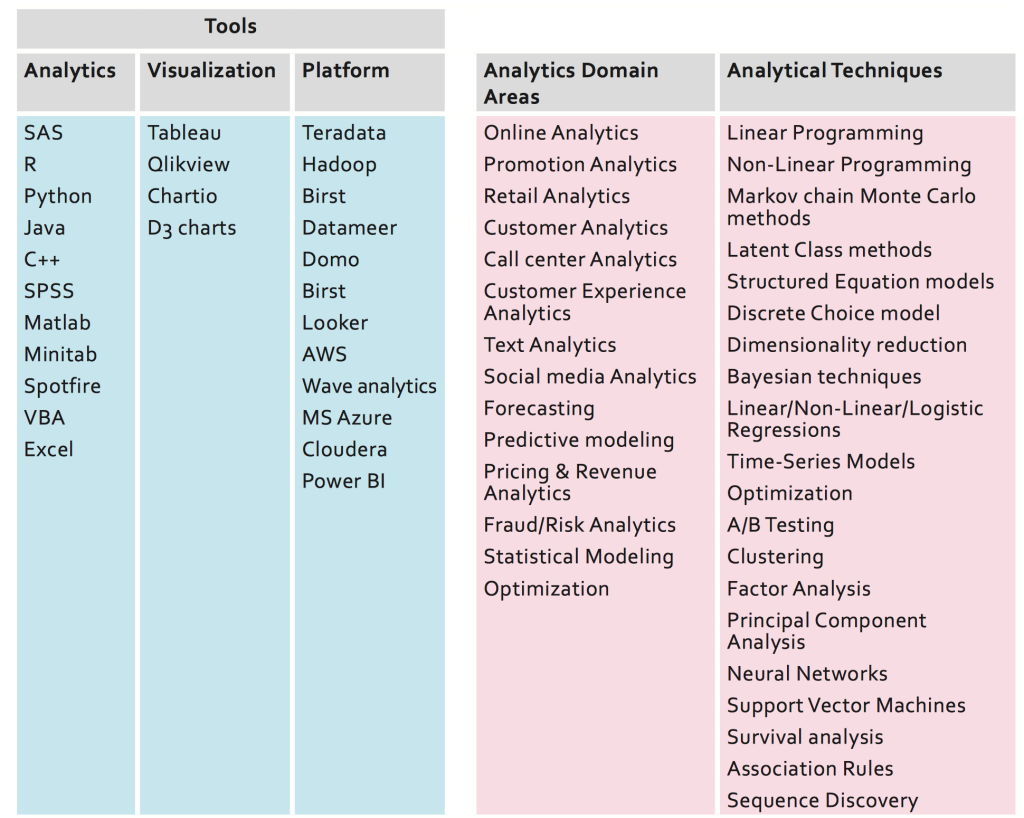In this whitepaper, we will discuss why transitioning from BI to advanced analytics is important, and the Nisum approach to helping our clients scale the analytical robustness of their organizations.
Business Challenge
The voraciousness and complexity of data volume, velocity, the variety being generated by organizations today, often have the CIO, CAOs, and business heads thinking along the following lines How do I make my BI and data infrastructure and organizations more efficient? How can we generate more insights from the data? Based on these insights, how can we drive greater business impact from actions?
At Nisum, we advocate a multi-prong approach to address these questions wholistically The key components of this approach are in creating a strong data governance mechanism to ensure robust & scalable BI architecture and using advanced analytics built on this infrastructure to drive greater actionable insights
In this whitepaper, we will discuss the latter focusing on why the transition from BI to advanced analytics is important and the Nisum approach to helping our clients scale the analytical robustness of their organizations
The Advanced Analytics Imperative
According to multiple CIO surveys, most of the C-suite executives agree that Analytics is an enabler of competitive advantage, in fact, Analytics/Big Data is a top-3 $ investment category for CIOs in the 2016-17 cycle in addition to cloud computing & security The top Analytics investment areas specifically are: Predictive Analytics, Visual Dashboards, and Data warehousing It is also widely known that companies leveraging analytics have demonstrably higher revenue & lower costs (1-3%) compared to those that don’t All these make executing on advanced analytics paradigms imperative for all business today
However, turning a mountain of data into insights is not always easy In our experience, most mid-size and even many large organizations, typically are well-evolved and with good future plans when it comes to traditional BI departments; however, we have often seen that they lag behind in usage of this infrastructure to generate actionable insights and turn those BI investments into additional revenue & profits
The table below shows a Nisum framework for a quick assessment of where your organization might be on the BI – Analytics continuum.

From our experience in working with clients in several verticals, the two most common challenges cited for this lag in the evolution are as follows:
- Difficulty in managing the complexity of data sources consistently and efficiently, regardless of the size of the organizational data
- Lack of appropriate analytics skills to unearth insights, particularly those that are directly actionable and leading to clear business impact in revenue or profit
For many companies, the BI to Analytics transition often starts with asking a different set of questions than ones that merely describe a certain aspect of the product or customer or promotion or customer contact/behavior in the past
Asking the Right Questions
Consider, a typical mid-size retailer with several hundred million dollars in annual revenues, multiple products or categories, and a diverse client base in multiple geographies We can see below how the questions asked about a typical customer, Nisa in the organization differ depending on where a client is in their BI – Analytics evolution The organizations that ask and answer the advanced, predictive and future-looking questions, typically do better with respect to business results, compared to those asking more descriptive and historical business questions early in the evolution
Early in the Analytics Evolution
- What products did Nisa buy last week?
- How much did Nisa spend last month?
- To what promotions did Nisa respond to last month?
- How long has Nisa been a customer?
- Is Nisa spending more or less this month compared to last month?
- What is the trend of Nisa’s spending month over month this year?
- Is Nisa a web or phone sales customer?
- Has Nisa called our customer service to date?
- What are the demographic details (gender, zip code, income level) of Nisa? n Which customer cohort does Nisa belong to?
Advanced in the Analytics Evolution
- How many times is Nisa likely to buy our products this summer?
- What promotions is Nisa likely to use?
- What is the likelihood that Nisa will buy product Y?
- What is the probability that Nisa will buy product Z after she buys product Y?
- What is the profit potential of Nisa in 1 year?
- What is the likelihood of Nisa’s churn as a customer within 3 months?
- Which of our customers are similar to Nisa in buying behavior?
- What promotions or products will get Nisa to contact us 2 more times a month?
- What profile or cohort types give us the best lifetime value?
A few other examples related to questions about customers, revenue, and marketing or promotions are continued below.

An advanced analytics organization also looks at its marketing programs differently
to get more value out of every dollar it spends on its promotions Take, for example, a program or marketing intervention many retailers like the above may have aimed at gaining back attrited customers or customers on brink of churn An advanced analytics organization commonly asks the following questions of such a program
Business Question:
- How do I win back cancel-risk customers for product P?
Analytics Questions:
- Who are the cancel-risk customers?
- What is the predicted cancel rate for a given customer cohort?
- What is the likelihood/probability of them canceling by each customer?
- What is the historical cancel rate trend for this customer set?
- What are some leading behavioral indicators for cancel-risk customers?
- What type of offers hast the best response rates for this customer set?
- What is the best time/date/day/time to contact this customer set in what channel?
- How do we segregate the test and control groups?
- What is the best offer/creative recipes to test for the program?
- What is the likely win-back rate for this customer set?
- If we did this win-back program, what is the expected ROI?
- What is the predicted confidence level for the repeatability of the program?
Nisum Advantage
As shown in the figures above, asking the right set of questions in multiple domain areas, is only the first step in advancing the analytics maturity of the organization. How do organizations answer these questions? Typically, it is through a cohesive set of tools, techniques, and people – the most important being people, with specialized skills in different domains, analytics techniques, and tools in addition to presentation skills (both verbal and visualizations) A subset of these is mentioned below.

Our Approach
Given these multi-dimensional complexities, making the transition from a traditional BI organization to actionable analytics empowered organization is not easy We have seen many companies attempt to do it organically and not create scalable and sustainable efficiencies over the long term At Nisum, we are passionate about using big data to create successes for our clients We have experience creating both specific short-term wins and long-term organizational impacts leveraging your current BI & Analytics investments.
We could work with your business or IT organization on a limited scope and specific business problem to show quantifiable impact using BI and Analytics or create a longer-term roadmap for sustained BI and analytics success for your organization Specific projects include conversion/leakage improvements, customer contact reductions, marketing ROI improvements, demand generation, and repeat rate optimizations, fraud reductions, etc.
Our flexible engagement model allows us to work together with you on a specific project by project basis or on strategic value-driven partnership terms Our on-shore, near-shore, off-shore, and hybrid business models can bring in unique business advantages while enabling around the clock BI and Analytics support that is custom designed to suit your business requirements.




